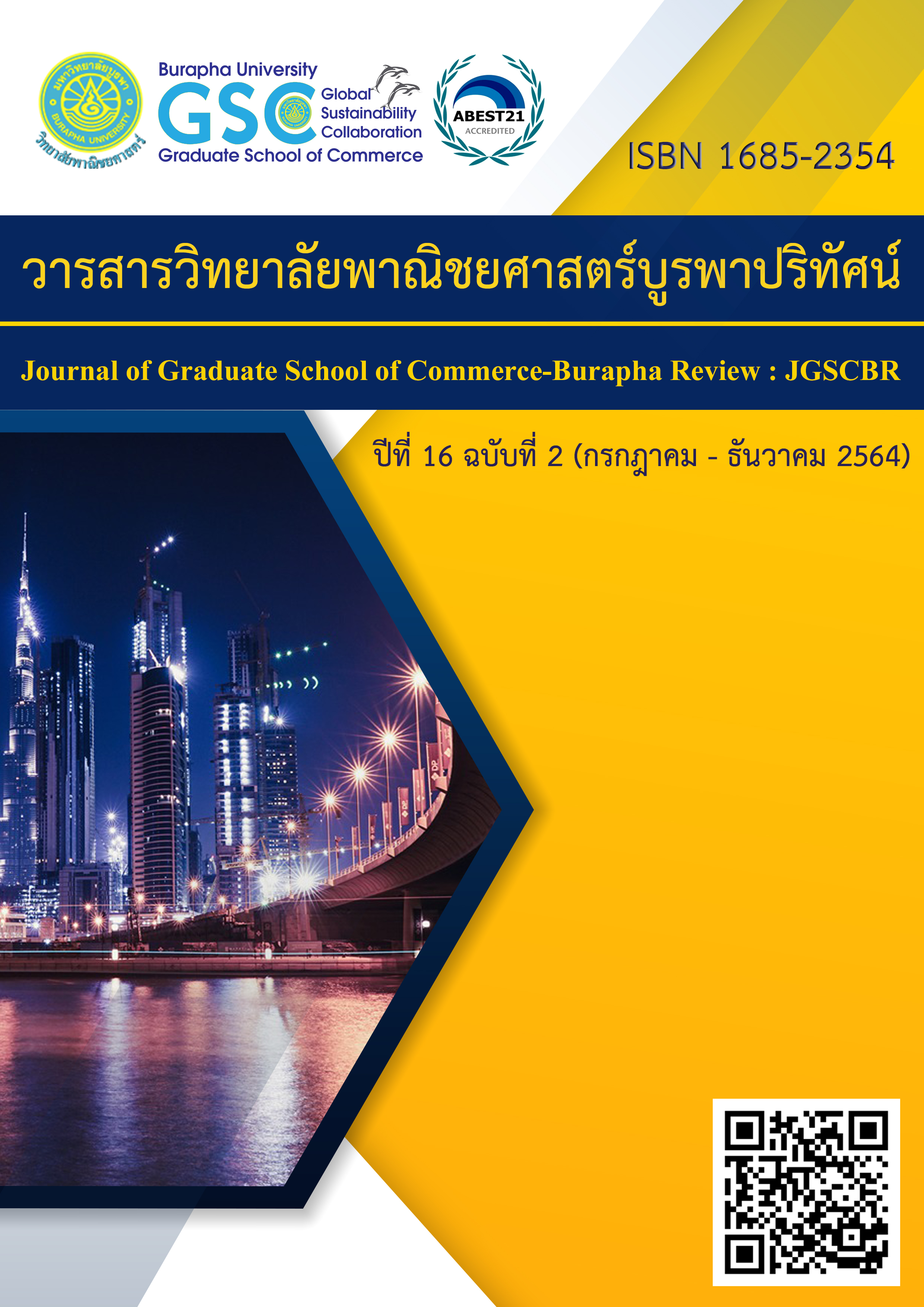FACTORS INFLUENCE ON TECHNOLOGY ACCEPTANCE OF AUTOMATION IN ELECTRONIC INDUSTRY MANAFACTUEING: A CASE STUDY OF ELECTRONIC FACTORY IN LEAM CHABANG INDUSTRIAL ESTATE
Main Article Content
Abstract
The objectives of this study are 1) to study the influence of perception of perceived ease of use on perceived usefulness of automation technology, 2) to investigate the influence of the perceived usefulness on attitude towards using of automation technology, 3) to examine the influence of perceived ease of use on attitude towards using of automation technology, and 4) to study the influence of attitude towards using on technology acceptance of automation technology. The questionnaire survey was used to collect data from 277 employees in an electronics factory in Laem Chabang Industrial Estate, using the sample using simple random sampling. The statistics used were frequency, percentage, mean, standard deviation, and multiple regression analysis.
The results showed that 1) the factor of perceived ease of use was found to positively influenced perceived usefulness of automation technology as a significant level of 0.05. 2) the factor of perceived usefulness was found to positively influenced attitude towards using of automation technology as a significant level of 0.05. 3) the factor of perceived ease of use was found to positively influenced attitude towards using of automation technology as a significant level of 0.05. 4) the factor of attitude towards using was found to positively influenced technology acceptance of automation technology as a significant level of 0.05.
Article Details
The owner of the article does not copy or violate any of its copyright. If any copyright infringement occurs or prosecution, in any case, the Editorial Board is not involved in all the rights to the owner of the article to be performed.
References
http://www.tpa.or.th/publisher/pdfFileDownloadS/tn246_p38-41.pdf, 20 มิถุนายน 2563.
ณัฐพงศ์ ยาทิพย์. (2560). การยอมรับการใช้เทคโนโลยีสารสนเทศ คุณภาพสารสนเทศ คุณภาพการบริการ
อิเล็กทรอนิกส์ที่ส่งผลต่อความพึงพอใจในการใช้บริการระบบจอง-ซื้อบัตรชมภาพยนตร์ผ่านโมบาย
แ อพพลิเคชั่น กรณีศึกษา บริษัท เมเจอร์ ซีนีเพล็กซ์ กรุ้ป จำกัด. วิทยานิพนธ์การศึกษามหาบัณฑิต สาขา
การบริหารและพัฒนาอุตสาหกรรม, มหาวิทยาลัยเกษตรศาสตร์.
ธนาคารแห่งประเทศไทย. (2562). รายงานแนวโน้มเศรษฐกิจ ไตรมาส 1/2562 (Online).
https://www.nesdc.go.th/more_news.php?cid=747&filename=index, 20 มิถุนายน 2563.
นิคมอุตสาหกรรมแหลมฉบัง. (2561). รายงานการศึกษาความเหมาะสมการจัดตั้งเขตส่งเสริมเศรษฐกิจพิเศษเพื่อ
กิจการ อุตสาหกรรมOnline).https://www.eeco.or.th/webupload/filecenter/html/establishment/
Feasibility/017.pdf, 20 มิถุนายน 2563.
ปรเมธี วิมลศิริ. (2559). แผนงานพัฒนาระเบียงเศรษฐกิจภาคตะวันออก (Online).
https://www.nesdc.go.th/ewt_dl_link.php?nid=6381, 20 มิถุนายน 2563.
พรศรี ลีลาพัฒนวงศ์ และ ทิพวรรณ ปิ่นวนิชย์กุล. 2562. ปัจจัยที่มีอิทธิพลต่อการยอมรับนวัตกรรมและเทคโนโลยี
: กรณีศึกษา ยานยนต์ไฟฟ้าประเภทยานยนต์นั่งส่วนบุคคลไม่เกิน 7 คน (รย.1). วารสารวิจัยและพัฒนา มจธ.
42(2): 129-143.
ภาณุสิษฐ์ ตระกูลทุม. (2561). ปัจจัยที่มีอิทธิพลต่อพฤติกรรมความตั้งใจใช้ระบบธุรกิจอัจฉริยะ กรณีศึกษาบริษัท
ผลิตอุปกรณ์อิเล็กทรอนิกส์แห่งหนึ่งในเขตนิคมอุตสาหกรรมแหลมฉบัง. วิทยานิพนธ์การศึกษามหาบัณฑิต สาขาการบริหารและพัฒนาอุตสาหกรรม, มหาวิทยาลัยเกษตรศาสตร์.
ศศิจันทร์ ปัญจทวี. (2560). ปัจจัยที่ส่งผลต่อการยอมรับการใช้ระบบสารสนเทศกรณีศึกษา สถาบันการพลศึกษา
วิทยาเขตเชียงใหม่. วิทยานิพนธ์บริหารธุรกิจมหาบัณฑิต สาขาบริหารธุรกิจ, มหาวิทยาลัยราชภัฏเชียงใหม่.
สถาบันไฟฟ้าและอิเล็กทรอนิกส์. (2561). อุตสาหกรรมอิเล็กทรอนิกส์อัจฉริยะในโครงการระเบียงเศรษฐกิจภาค
ตะวันออก (Eastern Economic Corridor : EEC) (Online). http://eiu.thaieei.com/box/Research/38/EECver12-
18.pdf, 20 มิถุนายน 2563.
A, Shuhaiber., and I. Mashal. (2019). Understanding users’ acceptance of smart homes. Technology
in Society 58: 101110.
Ajzen, I. (1991). The Theory of Planned behavior. Organizational behavior and Human Decision
Processes 50(2): 179-211.
Ajzen, I., & Fishbein, M. (1980). Understanding attitudes and predicting social behavior.
Englewood Cliffs, NJ: PrenticeóHall.
Beyza, Sumer. (2018). Impact of Industry 4.0 on Occupations and Employment in Turkey.
European Scientific Journal April 2018 edition 14(10): 1857–7881.
Cronbach, Lee J. (1970). Essentials of Psychological Testing. 3rd ed. New York: Harper.
Frank, Karayianes. (2017). Aircraft Maintenance Engineering: Factors Impacting Airlines
E-Maintenance Technologies, Authoring and Illustrations. Business and Technology
Management, Northcentral University.
Fishbein, M., & Ajzen, I. (1975). Belie, Attitude, Intention and Behavior: An Introduction to Theory
and Research, Boston, MA: Addison-Wesley.
F. Davis. (1985). A technology acceptance model for empirically testing new end-user information
systems. Thesis in Massachusetts Institute of Technology.
F. D. Davis. (1989). Perceived Usefulness, Perceived Ease of Use, and User Acceptance of
Information Technology. MIS Quarterly 13(3): 319-339.
F. D. Davis, R. P. Bangozzi, and P. R. Warshaw. (1989). User Acceptance of Computer Technology:
A Comparison of two Theoretical Models. Management Science 35(8): 982-1003.
L. D. Morienyane., & A. Marnewick. (2019). Technology Acceptance Model of Internet of Things for
Water Management at a local municipality. 2019 IEEE Technology & Engineering Management Conference (TEMSCON) : 1-6.
Lorenzo, G. (2019). A Quantitative Analysis of Factors Affecting U.S. Drivers Intentions To Use
Autonomous Vehicles: Using The Car Technology Acceptance Model. Doctor of Philosophy,
Capella University.
S. S. Man. et al. (2020). Critical Factors Influencing Acceptance of AVs by Hong Kong Drivers.
IEEE 8: 109845-109856.
Neter, J., W. Wasserman and M. Kutner. (1989). Applied Linear Regression Models. Illinois: Irwin
O’brien, R. 2007. A caution regarding rules of thumb for variance inflation factors. Quality & Quantity 41 (5): 673-690.
O’brien, R. (2007). A caution regarding rules of thumb for variance inflation factors. Quality &
Quantity 41 (5): 673-690
Sandema-Sombe, C.N. (2019). Relationship Between Perceived Usefulness, Ease of Use, and
Acceptance of Business Intelligence Systems. Thesis in Walden University.
Yamane, Taro. (1967). Statistics, An Introductory Analysis 2nd Ed. New York : Harper and Row.
W, Wu., & D. Shang. (2019). Employee UI of U-Learning Technology. IEEE Access 7: 34170-34178


